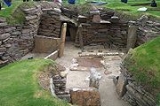
Heart of Neolithic Orkney
Encyclopedia
Heart of Neolithic Orkney refers to a group of Neolithic
monuments found on the Mainland, one of the islands of Orkney, Scotland. The name was adopted by UNESCO
when it proclaimed these sites as a World Heritage Site
in 1999.
The site of patrimony currently consists of four sites:
Ness of Brodgar
is an archaeological site between the Ring of Brodgar and the Stones of Stenness that has provided evidence of housing, decorated stone slabs, a massive stone wall with foundations, and a large building described as a Neolithic "cathedral".
Neolithic
The Neolithic Age, Era, or Period, or New Stone Age, was a period in the development of human technology, beginning about 9500 BC in some parts of the Middle East, and later in other parts of the world. It is traditionally considered as the last part of the Stone Age...
monuments found on the Mainland, one of the islands of Orkney, Scotland. The name was adopted by UNESCO
UNESCO
The United Nations Educational, Scientific and Cultural Organization is a specialized agency of the United Nations...
when it proclaimed these sites as a World Heritage Site
World Heritage Site
A UNESCO World Heritage Site is a place that is listed by the UNESCO as of special cultural or physical significance...
in 1999.
The site of patrimony currently consists of four sites:
- MaeshoweMaeshoweMaeshowe is a Neolithic chambered cairn and passage grave situated on Mainland, Orkney, Scotland. The monuments around Maeshowe, including Skara Brae, were designated a UNESCO World Heritage Site in 1999. It gives its name to the Maeshowe type of chambered cairn, which is limited to Orkney...
- a unique chambered cairnChambered cairnA chambered cairn is a burial monument, usually constructed during the Neolithic, consisting of a cairn of stones inside which a sizeable chamber was constructed. Some chambered cairns are also passage-graves....
and passage gravePassage gravethumb|250px|right|A simple passage tomb in [[Carrowmore]] near [[Sligo]] in IrelandA passage grave or passage tomb consists of a narrow passage made of large stones and one or multiple burial chambers covered in earth or stone. Megaliths are usually used in the construction of passage tombs, which...
, aligned so that its central chamber is illuminated on the winter solsticeWinter solsticeWinter solstice may refer to:* Winter solstice, astronomical event* Winter Solstice , former band* Winter Solstice: North , seasonal songs* Winter Solstice , 2005 American film...
. It was looted by Vikings who left one of the largest collections of runic inscriptions in the world. - Standing Stones of Stenness - the four remaining megalithMegalithA megalith is a large stone that has been used to construct a structure or monument, either alone or together with other stones. Megalithic describes structures made of such large stones, utilizing an interlocking system without the use of mortar or cement.The word 'megalith' comes from the Ancient...
s of a henge, the largest of which is 6 metres (19 ft) high. - Ring of BrodgarRing of BrodgarThe Ring of Brodgar is a Neolithic henge and stone circle on the Mainland, the largest island in Orkney, Scotland...
- a stone circle 104 metres in diameter, originally composed of 60 stones set within a circular ditch up to 3 metres deep and 10 metres wide, forming a henge monument. It has been estimated that the structure took 80,000 man-hours to construct. - Skara BraeSkara BraeSkara Brae is a large stone-built Neolithic settlement, located on the Bay of Skaill on the west coast of Mainland, Orkney, Scotland. It consists of ten clustered houses, and was occupied from roughly 3180 BCE–2500 BCE...
- a cluster of ten houses making up Northern Europe’s best-preserved Neolithic village.
Ness of Brodgar
Ness of Brodgar
Ness of Brodgar is an archaeological site covering excavated from 2003 onwards between the Ring of Brodgar and the Stones of Stenness in the Heart of Neolithic Orkney World Heritage Site near Loch of Harray, Orkney, in Scotland...
is an archaeological site between the Ring of Brodgar and the Stones of Stenness that has provided evidence of housing, decorated stone slabs, a massive stone wall with foundations, and a large building described as a Neolithic "cathedral".

